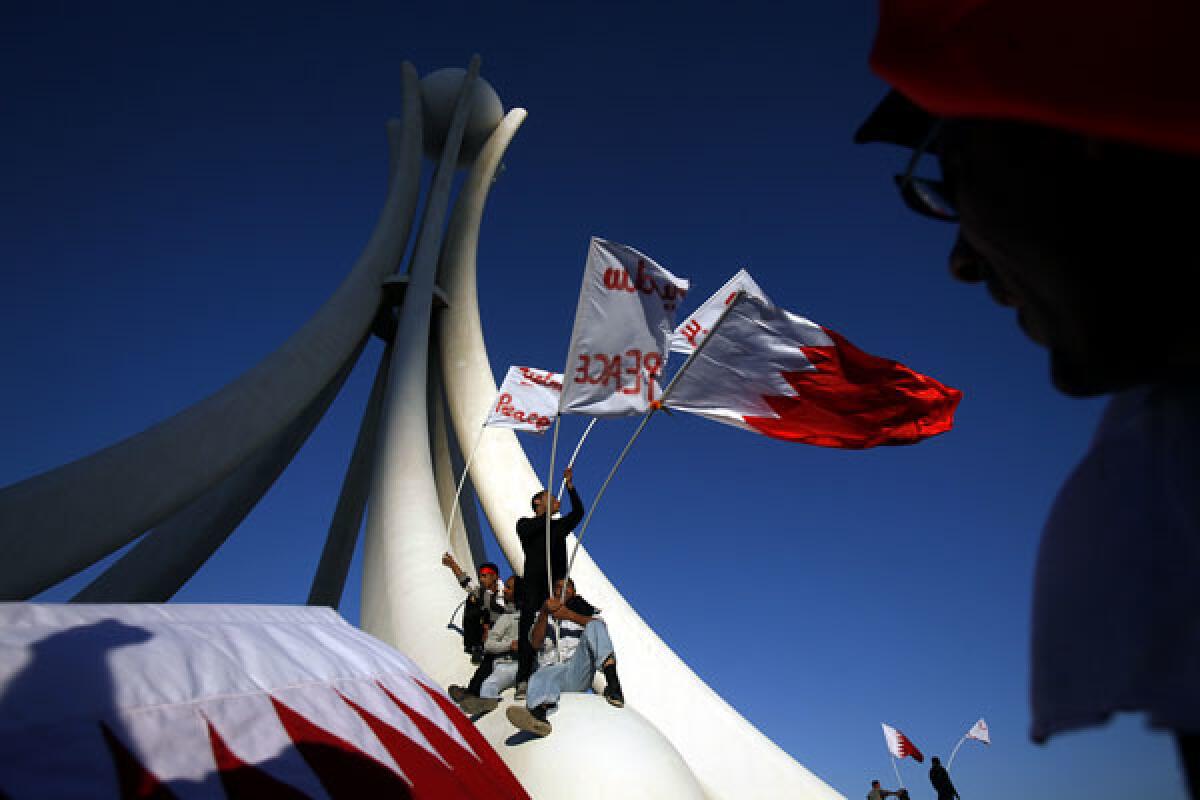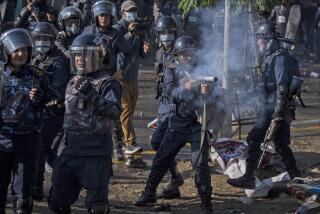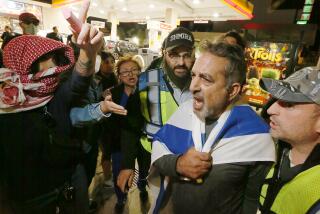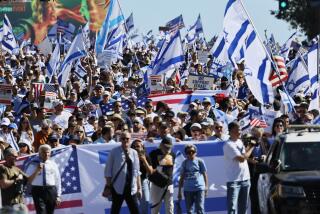Bahrain protesters back at Pearl Square despite violence

Ali Mahmoud was one of the first to retake Pearl Square.
The 42-year-old had watched the protests on television, and seen security forces expel anti-government demonstrators from the square in central Manama two days before. He knew he had to go where his countrymen had been shot at, had been gassed, had been beaten.
When Mahmoud and hundreds of other men approached the square Saturday, policemen fired off tear-gas canisters and Mahmoud found himself retreating through bushes. But not for long. Hours later, red welts marked his arms from the final skirmish before the Bahraini police retreated on orders of Crown Prince Salman ibn Hamed Khalifa.
“It was my first time, but I felt ashamed if I didn’t go with them,” Mahmoud said.
The demonstrators let out wild cheers at being back in the plaza that has come to embody the democratic aspirations of Bahrainis, much as Cairo’s Tahrir Square proved the beating heart of Egypt’s popular uprising.
Mahmoud stood proudly as teenagers sprayed graffiti on the plaza’s pearl statue and men and women carried around roses and offered food.
“Now the fear has disappeared,” he said.
The thousands who paraded in Pearl Square on Saturday night believed they had journeyed too far to stop their uprising now. Just as the Egyptians in Tahrir Square mourned their dead and vowed their passing would produce major social change, the Bahrainis now found resolve in their grief.
At least six Bahrainis have died since Monday, and hundreds more have been wounded.
The protesters, mainly from Bahrain’s Shiite majority, expressed resentment over the absolute rule by the island’s small ruling Sunni family. The demonstrators were tired of state corruption, the heavy-handedness of the security forces and a lack of basic freedoms.
Gathered in the square, they knew this was their moment.
The protesters remembered the mid-1990s, the last time Shiite Bahrainis launched mass demonstrations against their government. Some of them had been jailed in the crackdown that followed.
The difference between then and now is the state’s loss of control over information. Today, the protesters ping messages and photographs of the state’s alleged abuse through computers and smart phones.
And the world is watching. In the 1990s, when the state sought to put down Shiite popular protest, satellite television had not blossomed, and it was far easier for the royal family to manage the message.
There was confusion about whether Saturday’s decision to allow protesters to enter Pearl Square amounted to a breakthrough between the government and the demonstrators. On Twitter, Bahrain’s Information Ministry said the state had begun “a process of dialogue” with the opposition, but the demonstrators seemed taken aback by the news and denied there had been any talks.
The push by the government to proclaim progress is very much linked to how Bahrain is perceived in the world. The images of bleeding protesters have provoked international criticism. The demonstrations had already cast doubt on whether Bahrain could go ahead this year with its annual Formula One race, scheduled for mid-March. Formula One said it was closely watching the situation to determine whether the island was stable enough.
But resolution doesn’t seem imminent. The royal family is believed beset by palace intrigues involving Bahrain’s king and his uncle, the longtime prime minister, and the crown prince.
“I don’t think they will let the protesters stay for long. I guess the government pulled out to show reasonableness from its side,” said Adel Maawdah, the deputy chief of the country’s security committee in parliament. “If they discover it’s not useful and it will paralyze the country, they have to do something, but we pray there are no more clashes or at least no bloody clashes.”
As night fell, people in the square were unsure whether the government really would allow them to remain or whether they should brace for another crackdown.
Alaa Mohammed, an engineer, said he was close friends with one of the men who died two days before when police raided the square in the early morning hours. He remembered the friend, Ali Moumen, as a talented engineer. It bothered him to think that his blood could be spilled in vain.
He also was scarred by his own experience in the 1990s when Shiites started demanding that the government reopen the dormant parliament. In the mass arrests that followed, Mohammed was accused of putting up anti-government graffiti and jailed. He was 13.
He swore that whatever happened in the days to come, he would do his best to hold on in the square, and if the government drove the protesters out, he would keep coming back. “Freedom is an expensive thing,” he said.
Abdul Elah was draped in a Bahrain flag dappled in blood. He limped, and supported himself on a cane. Early Thursday, he said, a security officer had stabbed him in the leg when the force attacked and chased out the sleeping protesters.
And now he was back. He too remembered how the government deployed its security personnel against the Shiites during the 1990s campaign. Elah said he was jailed for two months when he was 17 and his brother for four years.
“I want to get my freedom for my children,” he said.
Around him, volunteers set up tents, and doctors and nurses rebuilt their clinic. The space twinkled with hundreds of gleaming white candles for the dead.
The square was becoming a village, but no one knew for how long.
More to Read
Start your day right
Sign up for Essential California for news, features and recommendations from the L.A. Times and beyond in your inbox six days a week.
You may occasionally receive promotional content from the Los Angeles Times.






